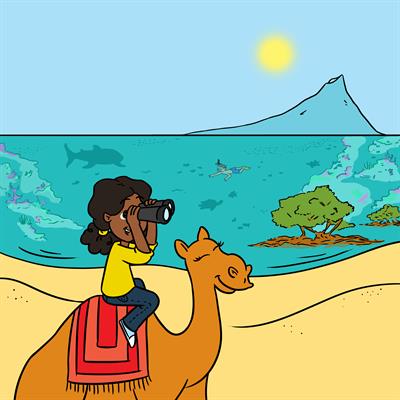
An Alien place on Earth: The Red Sea as a model for Future Oceans
Collection Editors
Christian Voolstra, Rúben CostaViews
387,086 viewsParticipating Sections
Submission Deadline
Closed
Articles

Biodiversity
03/11/2022
Salt and Sugars May Help Overheating Corals
Authors
Hagen M. Gegner, Rúben M. Costa
Biodiversity
17/12/2021
Microplastics: Small Particles, Big Threat
Authors
Silvia Arossa, Cecilia Martin, Susann Rossbach, Carlos M...
Biodiversity
15/10/2021
What Lives in the Ocean? An Introduction to the...
Authors
Marcelle M. Barreto, Marcela Herrera, Manuel Aranda
Biodiversity
11/08/2021
The Sparkling Tan: How Giant Clams Avoid Sunburns
Authors
Susann Rossbach, Sebastian Overmans, Ram C. Subedi, Carlos...
Biodiversity
27/10/2020
Out of This World: From the Bottom of the Red Sea...
Authors
André Antunes
Biodiversity
09/07/2020
Red Sea Fishes That Travel Into the Deep Ocean...
Authors
Maria Ll. Calleja, Xosé Anxelu G. Morán
Biodiversity
29/05/2020
A Unique Bellyful: Extraordinary Gut Microbes...
Authors
Matthew D. Tietbohl, David Kamanda Ngugi, Michael L. Berumen
Biodiversity
22/05/2020
An Incredible Invisible World: How Microorganisms...
Authors
Phillipe Rosado, Natascha Varona, Jonathan A. Eisen, Raquel...
Biodiversity
18/03/2020
Treasure Reef: Revealing the Hidden Creatures of...
Authors
Jennifer Otoadese, Susana Carvalho
Biodiversity
12/02/2020
Corals Are Sick: Black Band Disease Is Attacking
Authors
Ghaida Hadaidi, Christian R. Voolstra
Biodiversity
17/12/2019
Why Are Coral Reefs Hotspots of Life in the Ocean?
Authors
Nils Rädecker, Claudia Pogoreutz
Biodiversity
16/09/2019
How Seagrasses Secure Our Coastlines
Authors
Marco Fusi, Daniele Daffonchio
Biodiversity
07/03/2019
A Salty Coral Secret: How High Salinity Helps...
Authors
Hagen M. Gegner, Christian R. Voolstra
Biodiversity
27/02/2019
With a Little Help From Friends—How Algae Help...
Authors
Maha Joana Cziesielski, Manuel ArandaAbout this collection
Our oceans are changing. Elevated greenhouse gases caused the increase of Earth’s average temperature (or global warming) and contributed to what we now know as climate change. This in turn has a big influence on the oceans and the organisms that live in them. Given that oceans are changing so rapidly, how are marine organisms affected by this? Can they adapt? How can we study those adaptations? Where should we start?
In between Africa and Asia, in the Middle East region, lies a vast mass of seawater connected to the Indian ocean by its southern end. This water body is called the Red Sea, some say because of the presence of a reddish-brown cyanobacteria in its waters, others say because red was the color representing “south” (of the Mediterranean civilization) in ancient times. Its location makes it a unique environment with high temperatures and salinities (the amount of salt dissolved in water), creating a complex environmental gradient from north to south in its more than two thousand kilometers of length. Despite these harsh, almost alien conditions, the Red Sea is home to large green mangroves and seagrass meadows, more than a thousand species of fish (many of them unique to the Red Sea), hundreds of species of corals and countless invertebrates. At the microscopic level, we make new discoveries every day so that our knowledge on the diversity of bacteria, microalgae, and viruses is constantly increasing.
But if it is so difficult to sustain life in the Red Sea, how do all these organisms still prosper in it? This is one of many questions scientists are trying to answer by studying how abiotic factors such as temperature, salinity and nutrients of the Red Sea can affect its organisms (or biota). Moreover, due to its extreme conditions, the Red Sea can also act as a unique laboratory to study and learn about the future impacts of climate change on ecosystems: it represents a time machine that allows us to look into the future of tropical oceans and lets us understand how organisms thrive in environmental extremes.
The aim of this collection is to explore the current knowledge we have on the Red Sea biodiversity and its adaptability to environmental change. From coral reefs and the mutual beneficial relationships (symbiosis) between organisms, to seagrasses and brine pools, we aspire to learn how life can find a way to flourish even when the odds seem to be against it. More importantly, by understanding the present conditions of the Red Sea, we might be able to predict how organisms from other regions will adapt to fast changing climate.
Would you like to submit to this collection?
For researchers interested in submitting to this Collection, please consult our author guidelines and check that you have all the essentials included before submitting














